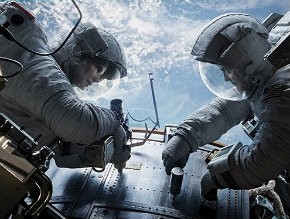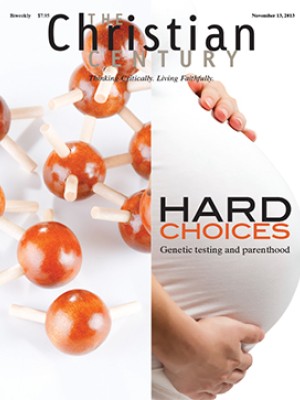Pulled home

Alfonso Cuarón’s movie Gravity is about a disastrous space shuttle mission. Medical doctor Ryan Stone (played by Sandra Bullock) and veteran astronaut Matt Kowalski (played by George Clooney) try to make their way back to Earth. Amid their struggle to survive, the two discuss the death of Stone’s daughter in a schoolyard accident. The Century’s media columnists Kathryn Reklis, Jason Byassee and Beth Felker Jones discussed the film with editor Amy Frykholm.
Amy Frykholm: How important was the setting of space to this film? Could the same story have been set underwater or in a desert?
Kathryn Reklis: For me, the setting of space was far more important than the story. Earth was a recognizable mystery floating in a disorienting infinity. More than a backdrop, it was a presence that I experienced as alien and intimate. I could recognize landmarks, but I could not fully reckon it as my home.
Read our latest issue or browse back issues.
Jason Byassee: Space is beautiful, but you understand why Kowalski is so in love with Earth. When you see the outlines of continents you think: that’s us—our world! It is so achingly beautiful that even those with no prayers are compelled to pray.
And yet the universe is indifferent to the tenuous nature of our lives. Like Stone’s daughter, we might slip on the asphalt, hit our head and die in an instant. We might never have emerged from the primordial slime. Or we might destroy ourselves.
Beth Felker Jones: I was moved by the insistence of the characters on talking continuously to those at home. So many of the messages in the film were forms of prayer—like the way they continue to report to ground control despite the fact that the voices from Houston have gone silent. Though Stone and Kowalski don’t know whether anyone can hear them, they don’t stop communicating.
When Stone finally establishes a radio link with someone on the ground, there’s a language barrier, but nonetheless she’s comforted by her contact with another human being and with the mundane realities of life on earth. The dog barking in the background of the radio call with the Chinese man becomes incredibly significant. Dogs are the antithesis of outer space, a reminder that the world still exists.
JB: That scene will not leave my mind. In conversation even with those we can’t understand or who can’t hear us, we bark like dogs, cry like babies and beg to come home. How beautifully and desperately human.
AF: What do we make of the fact that there is essentially only one character in this story, and that the character is a woman? Is this Stone’s story or is it Everyman’s (or Everywoman’s) story?
BFJ: I see it as an Everyman story. I wondered if Stone’s gender-ambiguous first name, Ryan, is important in this sense. I was annoyed by it at first, but it was refreshing to see a female protagonist in a story that is not about romance or sex. While Gravity still doesn’t pass the Bechdel test—according to which a story must have (1) two named women (2) who talk to each other (3) about something besides a man—Stone’s story isn’t defined by a man. I think a part of me wanted her story to be a woman’s story that wasn’t about sex instead of a story about a universalized human being.
KR: Recently online sci-fi fan girls have come up with the Mako Mori test: a story must have (1) at least one female character (2) who gets her own narrative arc (3) that is not about supporting a man. It’s a lower bar, but it helps to account for movies like Gravity that feature strong female leads in complicated stories.
BFJ: What about the way the director draws on birth and baptismal imagery? There is a long shot of Stone lying in the airlock in fetal position and then, after several trials, she emerges out of the water.
KR: I saw the imagery as evolutionary. When Stone first gets inside the space station, takes off her suit and coils her body, I immediately thought of the womb. So, too, her push through a small opening and through rushing water to emerge from the space capsule.
But when she was lying on the sand, pressed against that vibrant red earth and struggling to find her legs in the pull of gravity, I thought of evolution—the sheer impossibility of intelligent, communicating, suffering life rising out of the mud and water and walking away from the primal ooze on two legs.
BFJ: I thought of the primordial ooze, too, but the lack of specificity of the location bothered me. I suppose we couldn’t expect her to land in Illinois, and I suppose it mattered that Kowalski coaxed her to remember her specific location on Earth. Still, the film failed for me when the universal overshadowed or erased the particular.
KR: This aspect of the film reminded me of The Road, adapted by John Hillcoat from the novel by Cormac McCarthy. Space is a kind of postapocalyptic landscape, devoid of life and hostile to all the best and worst intentions of human activity. This parallel was driven home for me when Stone prays to the recently departed Kowalski. She has just confessed that she does not know how to pray, and yet she has resolved to keep going in the face of despair. Out of a deep, unreflective instinct, she prays to her dead comrade.
In The Road, after a man and his son discover a well-stocked bunker and sit down to eat their first satisfying meal in ages, the boy expresses a desire to give thanks. Knowing no other reality, he prays to the people who left the food, drawing them into a larger circle of the life that he and his father are struggling to live. There seems to be a profound parallel here: the possibility of continuing in the face of desolation has to do with extending oneself into a deeper and wider community of human belonging.
JB: I see these universal themes, but Cuarón also loves the particular. You can see it in his visual love of Mexico in Y Tu Mamá También and in the reference to Lake Zurich, Illinois, as Stone’s hometown. The particular here, however, is space.
KR: I would say not space but Earth is the particular. The film opens with a dire reminder that life in space is impossible. But Earth looms over every moment. Maybe Cuarón is pulling us back from the particulars of our lives to remind us that in the vast expanse of space, Earth itself and the human person are a mysterious miracle, a pulsating ball of particularity. And it is to this vision that Ryan is awakening—she wants in on the impossibility of being alive.
BFJ: The earth seems more like the particular than does space. There’s a sense of unreality attached to the threatening setting of space. The fluid motion of the actors through space feels like being underwater, cut off from the real world of light and air. Stone isn’t back home until she climbs out of the water and caresses the earth. The gravity of Earth, with all its massive reality, inexorably pulls Ryan back home out of the terrible dreamscape of space. It’s as though Earth itself won’t permit her to cut herself loose. It’s time to land, to be in place, feet on the ground.
JB: Cuarón seems to love the theme of transformation. He just never quite depicts it. I love the growth of Maribel Verdú’s character in Y Tu Mamá También, but it’s not quite believable. Nor is that of Theo Faron’s character in Children of Men. Stone’s transformation here is lacking something. I just don’t believe the breakthrough that comes by praying to a recently dead, barely known colleague. Better to aim those prayers to the other images of prayer in the film: the icons of St. Christopher, the Buddha, even the floating Marvin the Martian.
BFJ: I agree that Stone’s transformation isn’t particularly convincing. While her conversation with her dead colleague packs a large emotional punch, it remains too vague, too generic. Talking with a recently dead colleague can only reflect the most vague and colorless notions of possible life after death. This is an afterlife totally disconnected from the specifics of who God is, why creation matters and how Jesus might relate to it. It is ephemeral and unsatisfying.
It’s not that I would expect the film to adopt a robust Christian eschatology. But I might have been more convinced by a transformation attached to the icons or, far better, the voices of the real person, baby and dog that come from Earth.
KR: But perhaps Stone’s prayer is the lynchpin for the whole vision of earthly particularity we’ve been discussing. Maybe these icons are not vague, religious gestures, but instead represent the same thing that Stone will come to discover: the fragility of life requires a leap of faith—not to God per se, but to the mystery of human existence as a radical impossibility, a luminous mystery in the darkness of space. She embraces the frailty, finitude and improbability of life as a gift in and of itself, regardless of the span or specific outcomes. This is what the setting in space highlights so profoundly.







